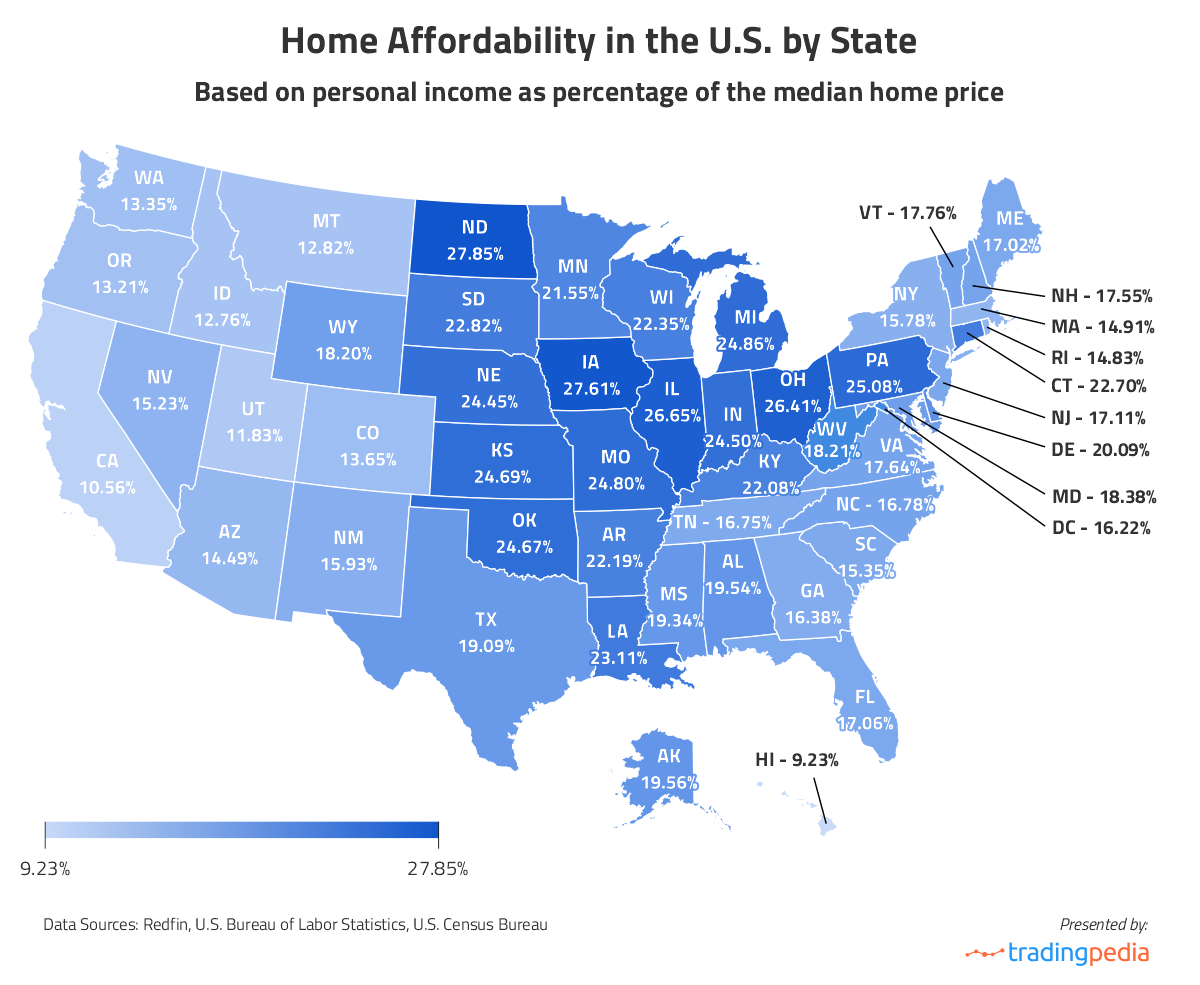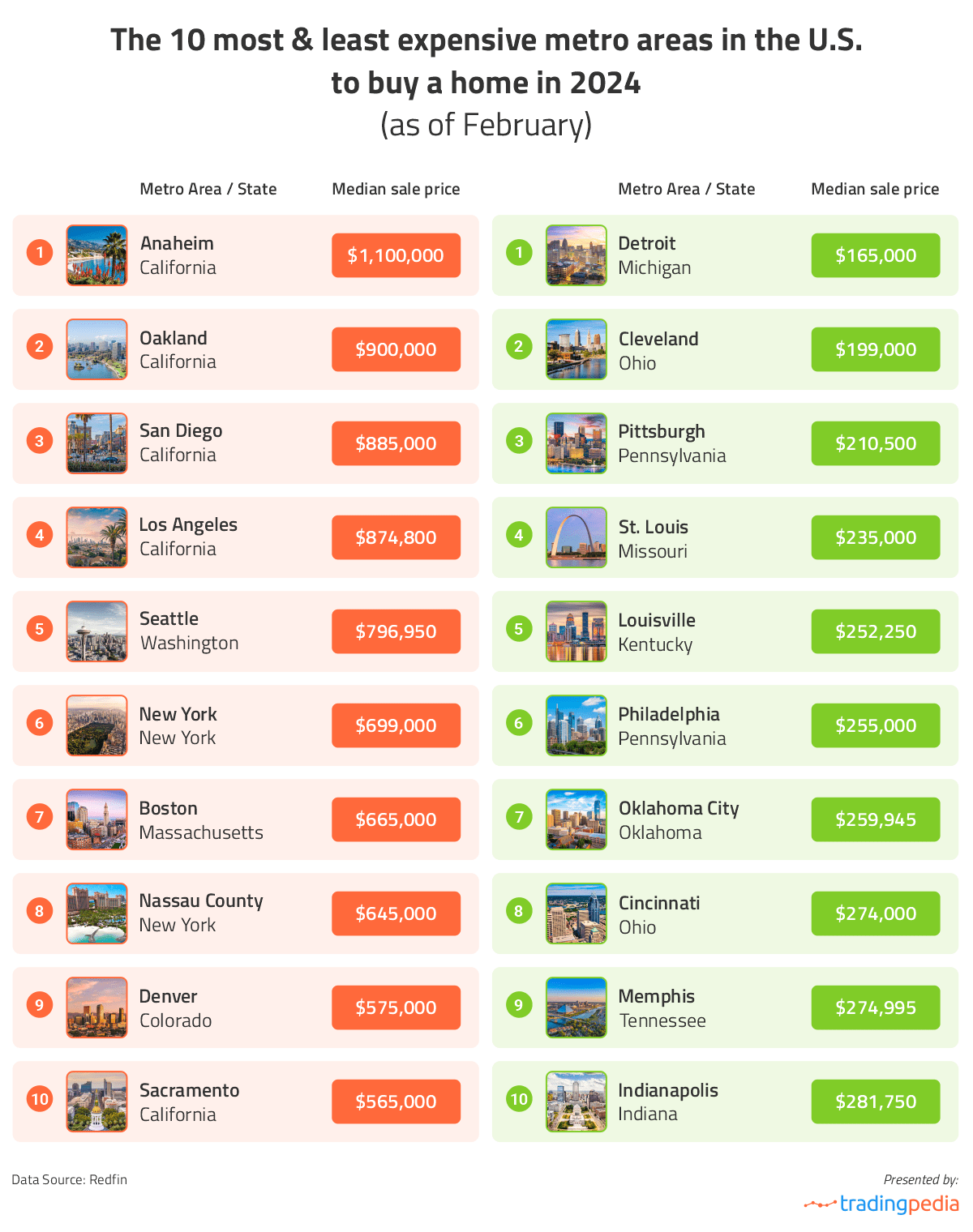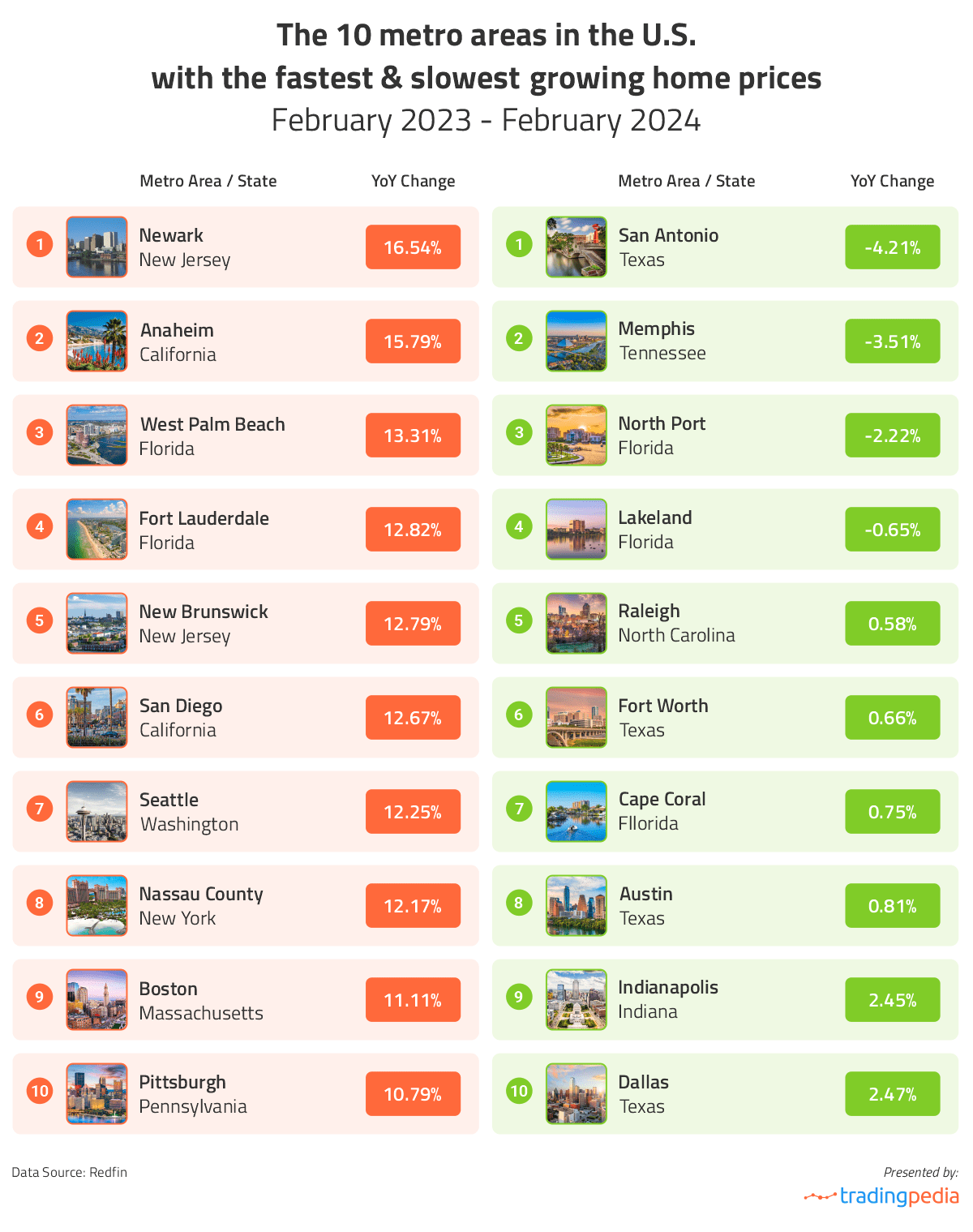In 2023, property sales dropped to their lowest level in almost three decades, while the median home price surged to near-record highs. Despite a slight decrease in mortgage rates before the end of the year, prices remain painfully elevated, without any market crash in sight, and a limited housing inventory is still failing to keep up with the high demand.
With median house prices now being six times the median income, some experts have called the housing market the least affordable in recent memory. Eager to find where people struggle to afford a home the most, the team at TradingPedia analyzed 2023 housing market data obtained from Redfin, along with personal income statistics, sourced by the U.S. Bureau of Economic Analysis for the third quarter of the same year. We calculated how many annual incomes it would cost the average American to buy a house in every state across the country, which allowed us to rank the states from least to most affordable.
We found out that even with the home affordability crisis gripping the U.S. real estate market, certain states offer relatively accessible housing alternatives when we look at home prices relative to personal incomes. To get a more visual representation of the pricing, we created a map illustrating the income per capita as a percentage of the median home price in every state. A higher percentage indicates a more balanced correlation between price and income and vice versa.


Although Californians grapple with the highest median home sale price in the country ($766,158), those living in Hawaii face even worse levels of home affordability as per our findings. The Aloha State features an annual income of $65,725, which constitutes solely 9.23% of the median home’s price there ($712,100). As a result, homebuyers need to set aside almost 11 years’ worth of earnings to buy a house with cash.
Meanwhile, residents of North Dakota enjoy the most affordable housing market, with annual incomes ($73,090/year) covering as much as 27.85% of the cost of a typical home ($262,465). Therefore, they must save their earnings for merely 3 years and 7 months to be able to afford one. Iowa follows as the second most accessible option, boasting the lowest median home price nationwide alongside an annual income averaging $62,062, which accounts for 27.61% of the amount required to purchase a house ($224,767).
Home Price vs. Personal Income: Most to Least Affordable U.S States


According to our findings, the U.S. median home price reached $408,428 last year, while the income per capita stood at $68,786 as of the third quarter. This translates to the median house costing about six times a person’s annual income.
If you are hoping to finally buy a house this year, you might find success in the Midwest, as 8 out of the 10 most affordable states, excluding southern Oklahoma and northeastern Pennsylvania, are Midwestern. With median home prices hovering under $300k, these states make homeownership attainable for many, especially since only Oklahoma has an annual income below $60k. Conversely, homes in the states with the highest price-to-income ratio, predominantly in the West, are far beyond the budget of most Americans, including the ones residing within them.
On the other hand, residents of the District of Columbia enjoy the highest per capita income in the country ($101,906/year) but this doesn’t necessarily equate to increased home affordability. According to our calculations, it would take them approximately 6 years and 2 months before they would have enough to afford a typical house ($628,133).
North Dakota, despite emerging as the most affordable state for house seekers, recorded the lowest number of home sales in 2023 (3,125) and the second-lowest figure when we consider the ratio of sales per 1000 people (3.99), trailing only behind West Virginia (2.44). Meanwhile, Florida may stand among the not-so-affordable U.S. housing markets (ratio of 5.86) but witnessed the highest number of home sales last year (379,355) and lead in sales per 1000 people, with a figure standing at 16.78. California, regardless of boasting almost 40 million residents, lags with the third-highest number of home sales in 2023 (260,107).
Furthermore, the long-standing lack of homebuilding, partly attributed to the stringent zoning laws in many states, including Montana and Oregon, leads to a discrepancy between supply and demand, further exacerbating the house affordability crisis. Another thing important to note is that coastal areas, as is the case with coastal cities in California, tend to be significantly more expensive than inland regions. This is due to their vulnerability to natural disasters such as hurricanes and flooding, resulting in higher taxes and insurance costs. Additionally, factors like access to amenities such as beaches and waterfronts, and longer transportation distances for goods, as seen in Hawaii, contribute to driving prices up.
The States With the Highest Home Price-to-Income Ratio


Residents of Hawaii enjoy one of the most breathtaking places on earth but at a high cost. Supposing their income is $65,725 per year, it would take them nearly eleven years to save for a home ($712,100) and it might cost them even more to live there, as prices in the Aloha State tend to be double those on the mainland.
California, on the other hand, holds the highest median home value across the country ($766,158), nearly double the national average of $408,428, alongside the highest per capita income within the top 10 list ($80,888/year), which results in second in the rank price-to-income ratio of 9.47. And yet, the Golden State boasts the highest number of home sales in 2023 within the top 10 list (260,107). The top six most expensive metro areas were, reportedly, all in California with San Francisco holding the top position. According to Redfin, San Francisco emerged as the metro with the highest outbound migration in 2023, with 28,365 people seeking to relocate.
Although it stands as the fourth least affordable U.S. housing market (ratio of 7.83), Idaho leads the top 10 list with the highest home sales per 1000 residents, a figure standing at 12.97. Utah (8.45), Montana (7.80) and Oregon (7.57) are also among the least affordable options, with Rhode Island ranking at the bottom (6.74).
The Most Affordable States for Homebuyers


North Dakota holds the title for the most affordable U.S. state, boasting a median home sale price well below the national average ($262,465) and the highest per capita income on the top 10 list ($73,090/year).
Iowa presents the second most accessible housing alternatives, featuring a reasonable ratio of 3.62. Of course, home prices in cities like Des Moines and Cedar Rapids can be significantly higher than in rural areas.
Among the top 10 “cheapest” U.S. housing markets, Illinois witnessed the most home sales last year (136,774), while Missouri boasts the highest ratio of home sales per 1000 people (12.32). Detroit stood out as the least expensive metro area for homebuyers, reported Redfin.
Meanwhile, Kansas surpasses Oklahoma on the list, securing a higher position, by providing a better per capita income ($64,078/year), even though its median housing cost is also more expensive ($259,558).
Metro Areas with the Cheapest and the Most Expensive Homes in 2024
The team at Tradingpedia also checked the latest home sales data for metropolitan areas from Redfin. We picked only metros where a minimum of 1,000 homes were sold in February. Of the 57 metro areas with at least a thousand sales, the Anaheim metropolitan area in California is the most expensive metro area in the U.S. for purchasing a home. The median price for all residential properties is $1,100,000. California dominates the list of the top five most expensive metros, with four claiming top spots in terms of median home prices.
On the flip side, Detroit, MI has the lowest home prices as of February 2024, with a median sales price of only $165,000. Cleveland, OH, follows with a price of $199,000, while the third-cheapest homes are in Pittsburgh, PA, where the median home price is $210,500.
The metro area with the fastest growing home prices is Newark, NJ, where the median price has increased by 16.54% since February 2023. Conversely, the San Antonio metropolitan area in Texas witnessed the largest year-over-year price drop among the analyzed metros, with prices declining by 4.21% from February 2023 to February 2024.




| Metropolitan Area | Median Sale Price (as of Feb 2024) | Change in Price YoY | Median Price per sq.foot | Homes Sold (in Feb 2024) |
|---|---|---|---|---|
| Anaheim, CA metro area | $1,100,000 | 15.79% | $652.39 | 1447 |
| Oakland, CA metro area | $900,000 | 10.26% | $594.66 | 1250 |
| San Diego, CA metro area | $885,000 | 12.67% | $588.65 | 1824 |
| Los Angeles, CA metro area | $874,800 | 10.04% | $582.80 | 3312 |
| Seattle, WA metro area | $796,950 | 12.25% | $461.40 | 2201 |
| New York, NY metro area | $699,000 | 9.22% | $418.27 | 3405 |
| Boston, MA metro area | $665,000 | 11.11% | $396.03 | 1781 |
| Nassau County, NY metro area | $645,000 | 12.17% | $412.32 | 1334 |
| Denver, CO metro area | $575,000 | 2.68% | $277.10 | 3032 |
| Riverside, CA metro area | $565,000 | 5.61% | $321.77 | 3165 |
| Sacramento, CA metro area | $565,000 | 7.01% | $333.78 | 1451 |
| Washington, DC metro area | $535,000 | 5.31% | $280.56 | 3508 |
| Portland, OR metro area | $532,000 | 3.30% | $297.33 | 1725 |
| Miami, FL metro area | $526,320 | 9.65% | $373.52 | 1788 |
| Newark, NJ metro area | $525,000 | 16.54% | $300.05 | 1080 |
| West Palm Beach, FL metro area | $500,000 | 13.31% | $296.89 | 1781 |
| New Brunswick, NJ metro area | $485,000 | 12.79% | $302.42 | 1535 |
| Phoenix, AZ metro area | $453,445 | 6.70% | $262.77 | 5278 |
| Nashville, TN metro area | $449,990 | 4.65% | $236.07 | 2134 |
| North Port, FL metro area | $449,000 | -2.22% | $264.65 | 1681 |
| Austin, TX metro area | $442,577 | 0.81% | $223.74 | 2161 |
| Fort Lauderdale, FL metro area | $440,000 | 12.82% | $305.14 | 1887 |
| Las Vegas, NV metro area | $435,000 | 9.79% | $247.79 | 2554 |
| Dallas, TX metro area | $415,000 | 2.47% | $199.89 | 4354 |
| Raleigh, NC metro area | $412,900 | 0.58% | $212.04 | 1499 |
| Charleston, SC metro area | $412,423 | 4.41% | $219.91 | 1198 |
| Cape Coral, FL metro area | $403,000 | 0.75% | $240.65 | 1481 |
| Orlando, FL metro area | $399,194 | 2.84% | $224.91 | 3036 |
| Charlotte, NC metro area | $394,995 | 7.27% | $210.40 | 2648 |
| Atlanta, GA metro area | $390,000 | 6.85% | $188.05 | 5636 |
| Richmond, VA metro area | $375,000 | 7.14% | $210.32 | 1168 |
| Tucson, AZ metro area | $373,743 | 10.09% | $218.89 | 1100 |
| Jacksonville, FL metro area | $372,890 | 7.77% | $207.54 | 1943 |
| Tampa, FL metro area | $371,200 | 2.77% | $223.45 | 4375 |
| Minneapolis, MN metro area | $359,991 | 4.65% | $192.21 | 2704 |
| Baltimore, MD metro area | $355,000 | 9.23% | $206.91 | 1999 |
| Fort Worth, TX metro area | $350,000 | 0.66% | $186.13 | 2043 |
| Deltona, FL metro area | $345,000 | 2.99% | $209.51 | 1025 |
| Myrtle Beach, SC metro area | $336,795 | 3.95% | $202.65 | 1343 |
| Houston, TX metro area | $330,000 | 3.13% | $161.88 | 6211 |
| Virginia Beach, VA metro area | $325,000 | 4.41% | $197.78 | 1807 |
| Columbus, OH metro area | $321,450 | 7.15% | $185.36 | 1720 |
| Lakeland, FL metro area | $319,995 | -0.65% | $182.57 | 1164 |
| Chicago, IL metro area | $317,500 | 9.48% | $200.07 | 4397 |
| Kansas City, MO metro area | $305,000 | 8.93% | $163.55 | 1764 |
| San Antonio, TX metro area | $295,000 | -4.21% | $163.55 | 2360 |
| Warren, MI metro area | $285,000 | 7.26% | $188.19 | 1900 |
| Indianapolis, IN metro area | $281,750 | 2.45% | $144.53 | 1991 |
| Memphis, TN metro area | $274,995 | -3.51% | $149.93 | 1007 |
| Cincinnati, OH metro area | $274,000 | 9.64% | $165.63 | 1624 |
| Oklahoma City, OK metro area | $259,945 | 8.31% | $153.31 | 1376 |
| Philadelphia, PA metro area | $255,000 | 8.51% | $192.83 | 1227 |
| Louisville, KY metro area | $252,250 | 6.91% | $152.80 | 1111 |
| St. Louis, MO metro area | $235,000 | 4.44% | $145.83 | 2285 |
| Pittsburgh, PA metro area | $210,500 | 10.79% | $152.68 | 1355 |
| Cleveland, OH metro area | $199,000 | 10.62% | $135.50 | 1591 |
| Detroit, MI metro area | $165,000 | 3.13% | $132.56 | 1244 |
Methodology
We also used data from the U.S. Bureau of Economic Analysis, providing personal income figures for the third quarter of 2023 for every state. To get the actual income per capita we divided the income of each state by its population.
Lastly, we determined the price-to-income ratio for each state by dividing its median home prices for the entire 2023 by the per capita income. As for the homes sold per 1,000 people figure, we divided the total number of properties sold in 2023 in every state by its population and then multiplied by 1000.
Full data



